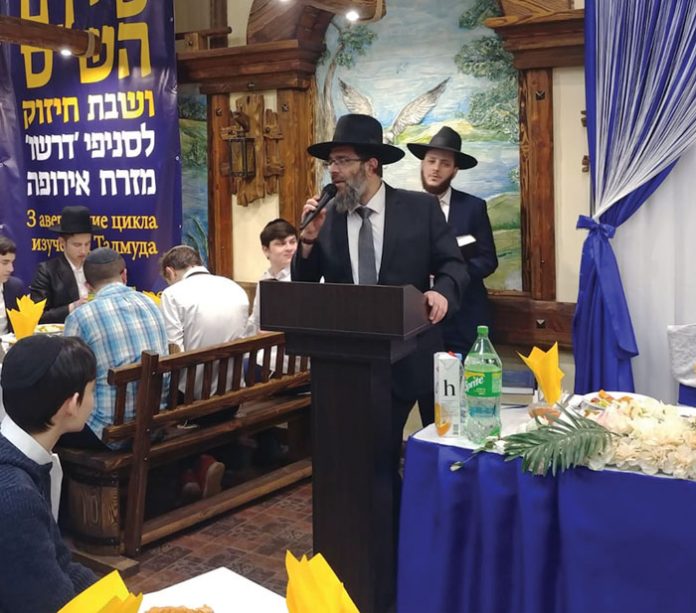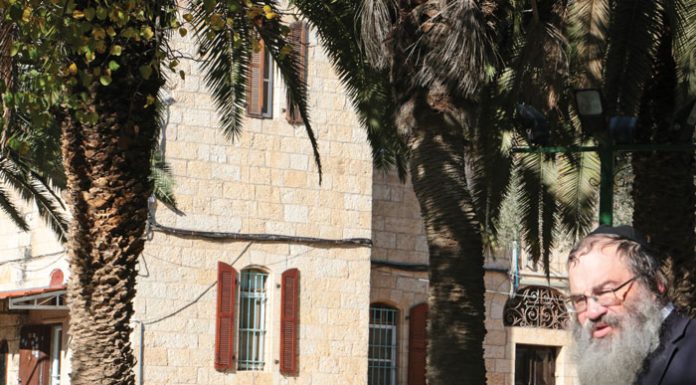The telephone connection was choppy, but the exciting sound of a celebration in the background was crystal clear. While practically everyone around the world was quarantined, in the country that had once been part of the Soviet Union, in a city decimated by the Nazis, a miracle of rebirth and celebration of Torah was taking place.
If not for the worldwide travel ban, I could have been there in Minsk and Pinsk too. I had been very much looking forward to attending this Dirshu Siyum in Eastern Europe, which began on Thursday evening, March 20, and continued through Shabbos Parshas Vayakhel-Pekudei. My zeide was from Minsk, and I probably still have cousins living there.
It was not to be. Instead, here I was alone in my study, listening intently to Rabbi Moshe Fhima’s account of the event. He tells me how many others from the United States, Eretz Yisrael and Western European countries who wanted to join in the celebration were also forced to remain behind. Even the nasi of Dirshu, Rav Dovid Hofstedter, was stuck in his native Toronto, watching the event unfold from afar.
The fact that a siyum haShas was celebrated by young men and adults who were born in the former Soviet Union, under Communist rule, was in itself a miracle. But celebrating with the sanction of the Belarus authorities, in a beautiful venue with nearly 200 Jews, at a time when Jews around the world are prohibited from gathering in groups larger than ten, was a miracle of miracles.
I remember learning in the name of Rav Chaim Volozhiner that the world was created so that half of it experiences daytime while the other half experiences night, so that there is always Torah study taking place at any given time, day or night.
Indeed, while Torah convocations and celebrations across the world are being shut down, nearly 200 Yidden held three major Torah celebrations. The Dirshu Siyum in the Minsk-Pinsk region of Belarus is a testimony not only to limmud haTorah, but to simchas haTorah and kavod haTorah as well.
In addition to celebrating the Dirshu Siyum HaDaf HaYomi, there was a siyum on Maseches Brachos made by a unique mesayeim, a bachur named Yisrael Meir Burak, and a siyum on all six orders of the Mishnah that was made by the young adults and talmidim of the Minsk-Pinsk region.
Had anyone claimed that one day there would be a time when Jews in America and Eretz Yisrael would not be able to gather in large groups to learn, no one would have believed him. But it is the time of Moshiach, and the side of the world that was once sequestered from Torah is celebrating, while the rest of the world is now sequestered.
The Hashgachah Ha’elyonah was evident in the arrangements. The siyumim were originally planned for early January, but the mechanchim and rabbanim in the area explained that due to the extreme cold in the northern areas of the former Soviet Union, it would be difficult to travel. The event was pushed off to late March; no one knew that the rest of klal Yisrael would be unable to travel at that time.
And so, at the Chaika Resort, in the Borisov region of Minsk Oblast, Belarus, the Torah was celebrated.
The Torah community of Belarus first emerged when it was part of Lithuania back in the late 1300s. At the time, Grand Prince Vytautas of Lithuania granted permission to Jews in Brest and Grodna to settle in Belarus. The borders between Poland and Lithuania were quite fluid, and sometimes cities that were in Poland (like Mir) became Lithuanian and vice versa. But for the large part, from the early part of the 1600s to the times of the Vilna Gaon, Belarus was under the influence of the Va’ad and direction of Lithuania. In the mid-17th century, between 80,000 and 90,000 Jews lived in the territory that is now Belarus.
As a result of the partition of Poland, Western Belarus became part of the Russian Empire, but Yiddishkeit continued to grow. With the influence of the Rebbe Menachem Mendel of Vitebsk and Rav Shneur Zalman of Liadi, the Baal HaTanya, who were in Eastern Belarus, the influence of chasidim helped spread Yiddishkeit. Karlin-Stolin was located near Pinsk and also contributed to the growth.





















